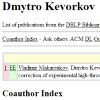| |
  
Jeremy G. Sumner,
Barbara R. Holland and
Peter D. Jarvis. The algebra of the general Markov model on phylogenetic trees and networks. In BMB, Vol. 74(4):858-880, 2012.
Keywords: abstract network, phylogenetic network, phylogeny, split, split network, statistical model.
Note: http://arxiv.org/abs/1012.5165.
Toggle abstract
"It is known that the Kimura 3ST model of sequence evolution on phylogenetic trees can be extended quite naturally to arbitrary split systems. However, this extension relies heavily on mathematical peculiarities of the associated Hadamard transformation, and providing an analogous augmentation of the general Markov model has thus far been elusive. In this paper, we rectify this shortcoming by showing how to extend the general Markov model on trees to include incompatible edges; and even further to more general network models. This is achieved by exploring the algebra of the generators of the continuous-time Markov chain together with the "splitting" operator that generates the branching process on phylogenetic trees. For simplicity, we proceed by discussing the two state case and then show that our results are easily extended to more states with little complication. Intriguingly, upon restriction of the two state general Markov model to the parameter space of the binary symmetric model, our extension is indistinguishable from the Hadamard approach only on trees; as soon as any incompatible splits are introduced the two approaches give rise to differing probability distributions with disparate structure. Through exploration of a simple example, we give an argument that our extension to more general networks has desirable properties that the previous approaches do not share. In particular, our construction allows for convergent evolution of previously divergent lineages; a property that is of significant interest for biological applications. © 2011 Society for Mathematical Biology."
|
|
| |
 
Andreas Spillner and
Vincent Moulton. Optimal algorithms for computing edge weights in planar split-networks. In Journal of Applied Mathematics and Computing, Vol. 39(1-2):1-13, 2012.
Keywords: abstract network, from distances, phylogenetic network, phylogeny, reconstruction, split, split network.
Note: http://dx.doi.org/10.1007/s12190-011-0506-z.
Toggle abstract
"In phylogenetics, biologists commonly compute split networks when trying to better understand evolutionary data. These graph-theoretical structures represent collections of weighted bipartitions or splits of a finite set, and provide a means to display conflicting evolutionary signals. The weights associated to the splits are used to scale the edges in the network and are often computed using some distance matrix associated with the data. In this paper we present optimal polynomial time algorithms for three basic problems that arise in this context when computing split weights for planar split-networks. These generalize algorithms that have been developed for special classes of split networks (namely, trees and outer-labeled planar networks). As part of our analysis, we also derive a Crofton formula for full flat split systems, structures that naturally arise when constructing planar split-networks. © 2011 Korean Society for Computational and Applied Mathematics."
|
|
| |
  
Philippe Gambette,
Vincent Berry and
Christophe Paul. Quartets and Unrooted Phylogenetic Networks. In JBCB, Vol. 10(4):1250004, 2012.
Keywords: abstract network, circular split system, explicit network, from quartets, level k phylogenetic network, orientation, phylogenetic network, phylogeny, polynomial, reconstruction, split, split network.
Note: http://hal.archives-ouvertes.fr/hal-00678046/en/.
Toggle abstract
"Phylogenetic networks were introduced to describe evolution in the presence of exchanges of genetic material between coexisting species or individuals. Split networks in particular were introduced as a special kind of abstract network to visualize conflicts between phylogenetic trees which may correspond to such exchanges. More recently, methods were designed to reconstruct explicit phylogenetic networks (whose vertices can be interpreted as biological events) from triplet data. In this article, we link abstract and explicit networks through their combinatorial properties, by introducing the unrooted analog of level-k networks. In particular, we give an equivalence theorem between circular split systems and unrooted level-1 networks. We also show how to adapt to quartets some existing results on triplets, in order to reconstruct unrooted level-k phylogenetic networks. These results give an interesting perspective on the combinatorics of phylogenetic networks and also raise algorithmic and combinatorial questions. © 2012 Imperial College Press."
|
|
|
 - forked on GitHub.
- forked on GitHub.













































